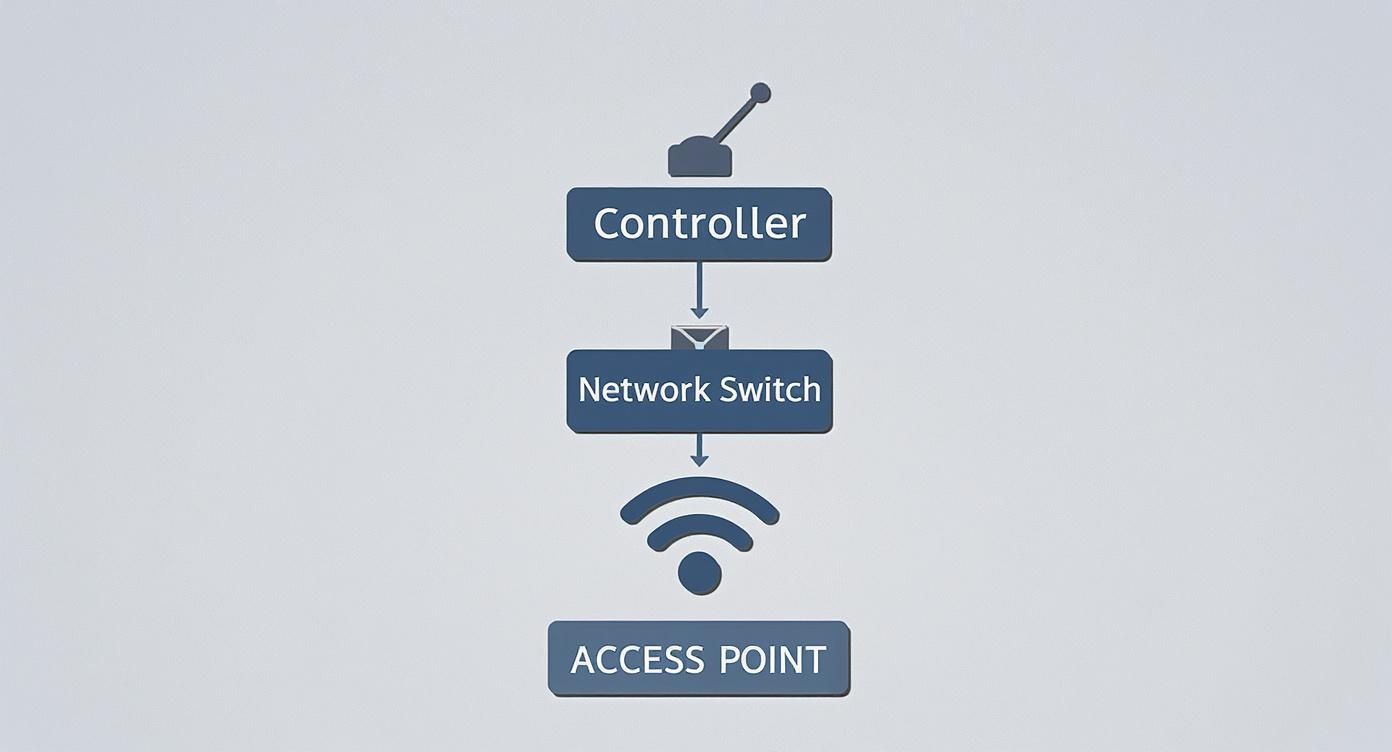Hey there! Let's talk about your network. A modern wireless network solution is way more than just a way to get online; it's the digital backbone that keeps your daily operations running smoothly. The real goal is to build a reliable, secure, and easily managed Wi-Fi environment that can handle everything from your most critical business systems to the phones and laptops your guests and employees bring in.
Beyond Buffering: How Modern Wi-Fi Powers Business
We've all felt the pain of a lagging Wi-Fi connection. But for any organization today, that spinning wheel isn't just a minor annoyance—it's a direct hit to productivity and growth. A truly effective wireless network solution pushes past basic connectivity to become a genuine business asset.
This is especially true when you build your network on robust hardware from industry leaders like Cisco and Meraki. Their equipment is engineered from the ground up to handle the intense demands of modern, device-heavy environments, laying the foundation for a seamless and secure experience.
This is what a high-performance wireless environment looks like in practice—technology working silently in the background, letting people focus on what matters without interruption.
Meeting Modern Demands
The need for a dependable wireless network solution is exploding across just about every sector. The global market is expanding at a breakneck pace, driven by an insatiable appetite for faster, more reliable connections. In fact, projections show the wireless infrastructure market rocketing from USD 223.86 billion in 2025 to a staggering USD 553.67 billion by 2032. This isn't just a trend; it's a fundamental shift in how businesses operate.
A well-designed network is non-negotiable for key initiatives in countless fields:
- Education: Effortlessly connecting hundreds of student and faculty devices for immersive digital learning.
- Retail: Keeping point-of-sale systems online while offering secure, branded guest Wi-Fi.
- Corporate: Supporting flexible Bring Your Own Device (BYOD) policies without compromising security.
The Role of Smart Authentication
In today's world, a single shared password for your Wi-Fi is a security nightmare waiting to happen. This is where modern authentication solutions make all the difference. Technologies like Captive Portals create a professional, branded login experience for guests, while security protocols like IPSK (Identity Pre-Shared Key) and EasyPSK assign unique credentials to every single user or device. This approach doesn't just boost security—it dramatically simplifies network management for IT teams juggling countless connections.
When you look at the top WiFi solutions for business, it’s clear that robust security and a great user experience are the name of the game.
Ultimately, thinking of a network upgrade as a strategic investment in reliability and user experience can open up a world of new opportunities for your organization. You can discover more about our approach to building powerful https://www.splashaccess.com/wifi-solutions-for-business/.
Deconstructing Your Wireless Network Infrastructure
Building a great wireless network is a lot like conducting an orchestra. Every instrument—every component—has a crucial part to play. For a flawless performance, they all have to work together in perfect harmony. If you only focus on one piece, say, just the violins, the whole symphony can fall flat. In Wi-Fi terms, that means dead zones, painfully slow speeds, and seriously frustrated users.
Let's break down the key players you'll find in any professional wireless network setup.
First up, you have the Access Points (APs). Think of these as the musicians in our orchestra. These are the physical devices you see mounted on ceilings or walls, and their one job is to broadcast the Wi-Fi signal. A typical home router tries to be a one-man band, but in a business environment, you need a whole team of specialized APs to blanket an area with strong, consistent coverage.
Here’s what a typical network management dashboard looks like. It gives IT teams a bird's-eye view of the entire system's health and performance at a glance.
This kind of centralized control is exactly what separates a professional solution from a jumble of standalone devices. It makes monitoring and making adjustments incredibly straightforward.
The Foundation of Performance
If the APs are the musicians, then the network switches are the stage they all perform on. Switches are the central hubs that physically link your APs, servers, and other wired devices together using high-speed connections. This is what lets data flow quickly and efficiently between every part of your network.
To make sure this foundation is rock-solid, investing in high-performance hardware is non-negotiable. This is where industry leaders like Cisco and Meraki really make a difference. Their gear is built from the ground up to handle the high-density environments you find in busy offices, schools, and retail stores. You get the kind of reliability you need for mission-critical operations. A robust infrastructure from a provider like Cisco Meraki is always the first step toward a dependable wireless experience.
The Conductor Unifying the System
The final piece of the puzzle is the controller, which serves as the orchestra's conductor. A controller is the centralized brain that manages all the APs on your network, making sure they work together seamlessly. It’s constantly optimizing performance, pushing out updates, and letting you manage the entire system from a single, unified dashboard.
A well-managed wireless network isn't just about giving people internet access. It's about delivering a consistent, secure, and scalable connection that actually supports your organization's goals, whether that's in a school, a retail store, or a corporate "bring your own device" (BYOD) environment.
This managed approach is absolutely essential for implementing modern authentication solutions. With a central controller, you can easily deploy sophisticated security features across the entire network, like:
- Captive Portals to create a branded guest login experience.
- IPSK and EasyPSK to assign unique, secure credentials to every single user and device.
This level of granular control is a game-changer for sectors like Education and Retail, where hundreds of new devices might connect every single day.
Of course, before you ever deploy a single piece of hardware, you have to understand the physical environment you're working with. You can learn more about this crucial first step in our guide to performing a proper site survey for your wireless network. A good survey ensures your "musicians" are placed in the perfect spots to deliver an amazing performance.
Smart Strategies for Securing Network Access
Handing out a single Wi-Fi password to everyone is like leaving your business's front door unlocked. It's a simple, common mistake that can expose your entire network to some serious risks. Modern network security isn't about building one big wall; it's about creating intelligent layers of protection that are both tough on threats and easy for your users.
This is where sophisticated authentication solutions come into the picture. Instead of one password for the whole building, imagine giving each person a unique, personal key. This approach dramatically strengthens your defenses and, just as importantly, gives you a clear view of who is on your network at all times.
Moving Beyond the Single Password
Let's be blunt: the traditional shared password model is fundamentally broken, especially for any business with more than a handful of users. It’s impossible to manage, track, or secure. Once that password gets out, it's out there forever, and you have no real control over who is using it.
That's why any wireless network solution worth its salt must use smarter authentication. Technologies like Captive Portals provide a professional and secure gateway for guests, while protocols such as Identity Pre-Shared Key (IPSK)—often called EasyPSK—take security to a whole new level for your trusted users and devices.
This is how a professional wireless network is typically structured, with a central controller managing switches and access points to enforce security policies from a single point.
This kind of centralized architecture is what makes it possible to roll out advanced authentication across an entire organization without a massive headache.
The Power of Unique Authentication
Think of EasyPSK as your network's digital keymaster. It gives you the power to generate a unique, private password for every single user or device. This is a complete game-changer for a few key reasons:
- Enhanced Security: If a device is lost or an employee moves on, you can instantly revoke their individual key without affecting anyone else on the network.
- Clear Accountability: You have a perfect record of which device belongs to whom. This makes troubleshooting and monitoring network activity incredibly straightforward.
- Simplified Onboarding: New users get their own credentials quickly and easily, often without needing a manual setup from the IT department.
In a Bring Your Own Device (BYOD) world, knowing exactly who and what is on your network isn't just a good idea—it's an absolute necessity. EasyPSK provides the granular control needed to manage this complexity securely.
This level of detailed control is crucial in busy environments like Education and Retail, where the sheer number of devices connecting and disconnecting can be overwhelming. In a corporate office, it’s the backbone of a secure BYOD policy, letting employees connect their personal devices without putting the internal network at risk. Of course, technology alone isn't enough; it has to be supported by a robust network security policy.
Comparing Modern Wi-Fi Authentication Methods
Choosing the right authentication method depends entirely on your needs—from providing simple guest access to securing a fleet of corporate devices. Here’s a quick breakdown of how these different approaches stack up.
| Feature | Single Shared Password | Captive Portal | IPSK / EasyPSK |
|---|---|---|---|
| Best For | Very small, private networks (e.g., home use) | Guest Wi-Fi in public venues (cafes, hotels) | Corporate networks, BYOD environments, schools |
| Security Level | Low | Moderate (often used for terms & conditions) | High |
| User Experience | Simple, but requires manual sharing | Professional, branded, but adds a login step | Seamless and automatic after initial setup |
| Management Overhead | High (changing the password is a pain) | Low (centrally managed) | Low (individual keys can be easily revoked or added) |
| Device Accountability | None | Basic (can track MAC addresses, emails) | High (every device is tied to a unique, identifiable key) |
As you can see, while a single password has its place, it falls short in any professional setting. IPSK/EasyPSK clearly emerges as the superior choice for securing trusted devices and creating a truly manageable network.
Cisco Meraki and Seamless Security
Modern networking platforms like Cisco Meraki are designed to make these powerful security features accessible to everyone, not just networking gurus. Through a clean cloud-based dashboard, an administrator can set up and deploy a Captive Portal or EasyPSK with just a few clicks. This tight integration removes the complexity that used to come with enterprise-grade security.
This kind of seamless link between the hardware (your access points) and the software (the management dashboard) ensures that your security policies are enforced consistently across every corner of your network.
This approach fits perfectly with a modern security mindset where you never assume trust. The demand for this level of security is skyrocketing; the next-generation wireless market is expected to hit an incredible USD 69.7 billion by 2035, all driven by the need for secure, high-speed connectivity. By adopting these smarter strategies today, you’re not just securing access—you’re building a foundation of trust for your entire digital operation.
Crafting an Engaging Guest Wi-Fi Experience
Guest Wi-Fi is so much more than a free internet connection—it’s your digital welcome mat. When a visitor walks into your space, their login experience is often the very first digital touchpoint they have with your brand. A clunky, generic, or unsecured login page immediately sends the wrong message. A polished, branded, and secure portal, on the other hand, can transform a simple amenity into a powerful engagement tool.
This is where a Captive Portal becomes your best friend. Think of it as the branded login page users see before they get full access to your Wi-Fi. Instead of just a password field, you can present a page that reinforces your brand identity, shares promotions, or gathers valuable insights from users who opt-in.
Here’s a great example of a clean, branded captive portal that makes the login process simple and welcoming.
This kind of professional entry point builds trust right away and leaves a much better first impression than a generic password prompt ever could.
Turning Connectivity into an Asset
The real magic happens when your captive portal works hand-in-glove with your network hardware. With a platform like Cisco Meraki, you can roll out stunning, secure portals without needing to be a web design guru. This tight integration is crucial for a reliable wireless network solution because it makes sure the login experience is just as solid as the connection itself.
Just think about how this plays out in the real world:
- Retail: A customer logs into your Wi-Fi and is greeted with a coupon for 15% off their purchase. You've just turned a free service into a direct sales driver.
- Corporate (BYOD): A visitor arriving for a meeting can quickly register themselves through the portal, which streamlines check-in and automatically notifies their host.
- Education: Students and guests can access the campus network simply by agreeing to the acceptable use policy, all managed through a single, straightforward interface.
This approach stops your Wi-Fi from being just another cost center and turns it into a valuable asset that improves your operations and makes for a better user experience. For a deeper dive, check out our guide on how to set up guest Wi-Fi.
Advanced Authentication for Today’s Needs
While captive portals are perfect for guests, you still need rock-solid security for trusted devices. This is where modern authentication solutions like IPSK (Identity Pre-Shared Key) and EasyPSK come into the picture. These technologies let you assign a unique Wi-Fi key to every single user or device, giving you a level of control that a single, shared password could never match.
For instance, a school can give each student's laptop its own EasyPSK. This ensures only authorized devices get on the educational network. If a device is ever lost or stolen, its key can be revoked in a snap without affecting anyone else.
A great guest experience is all about balance. It's about offering easy, welcoming access while maintaining ironclad security on the back end. Modern solutions let you achieve both without compromise.
By combining the marketing punch of a custom captive portal with the deep security of individual authentication methods like EasyPSK, you create a truly comprehensive wireless network solution. This dual approach neatly separates your guest traffic from your internal, trusted traffic. You're able to protect sensitive data while still providing a fantastic experience for visitors. Brands like Cisco have built their reputation on hardware that makes this level of sophisticated management possible, giving you total control over who gets on your network and how.
Tailoring Your Wi-Fi for Specific Industries
A generic, one-size-fits-all Wi-Fi network just doesn't work anymore. The demands of a bustling high school are worlds apart from a high-end retail store or a fast-paced corporate office. A truly effective wireless network solution is one that’s carefully shaped to fit its environment, turning basic connectivity into a real strategic asset.
It’s not just about providing internet access. A well-designed network becomes the invisible engine that drives daily operations, enhances user experiences, and protects critical data. This is where specialized hardware from brands like Cisco Meraki really shines, giving you the flexible foundation needed to solve specific industry problems.
Powering Modern Education
In an Education setting, the wireless network has to do it all. It needs the raw capacity to handle thousands of connections at once from student laptops, tablets, and phones. At the same time, it has to deliver the rock-solid performance needed for digital learning tools, online testing, and video lectures.
But it’s about more than just speed—security is everything. A school’s network must be a safe digital space, which makes advanced authentication solutions a must-have.
- Student Access: With EasyPSK, every student gets a unique Wi-Fi key tied to their device. If a student's laptop is lost, you can kill its access instantly without affecting anyone else.
- Faculty and Staff: Secure credentials ensure teachers and administrators can reliably access internal resources like gradebooks and administrative systems from anywhere on campus.
- Guest Access: A Captive Portal gives visitors and parents a simple, secure way to get online, keeping all guest traffic completely separate from the core educational network.
This kind of collaborative learning is only possible with a robust wireless network that can juggle multiple devices seamlessly, enabling the dynamic, interactive classroom that modern education demands.
Elevating the Retail Experience
For Retail businesses, a reliable wireless network solution has a direct impact on the bottom line. It’s the backbone for your most important systems: Point-of-Sale (POS) terminals, inventory scanners, and in-store digital signs. Any network downtime can mean lost sales and unhappy customers.
Beyond the essentials, Wi-Fi is also a fantastic tool for customer engagement. A well-managed guest network, accessed through a branded Captive Portal, can completely change the in-store experience. You can greet customers with special offers, ask for quick feedback, or encourage social media follows right when they connect. This turns a free amenity into a valuable source of customer data and a direct marketing channel. For other public-facing industries, you can check out our guide on hotel Wi-Fi solutions.
Securing the BYOD Corporate World
In today's corporate world, the line between personal and work devices has pretty much vanished. Bring Your Own Device (BYOD) policies are great for flexibility, but they create some serious security headaches. How do you let employees use their personal phones and laptops for work without opening up your network to threats?
This is where an intelligent wireless network solution using IPSK or EasyPSK is indispensable.
By giving a unique, private key to each employee's personal devices, IT teams can maintain tight control over who can access what. This ensures that only authorized users can connect to sensitive company resources, while also making it incredibly simple to add new employees or remove departing ones.
This approach, supported by platforms like Cisco Meraki, finds the perfect balance between user convenience and rock-solid security. It lets employees work the way they want while giving the company peace of mind that its data is safe.
This is especially critical as the wireless internet services market continues to explode, growing from USD 670.42 billion in 2024 to an estimated USD 705.93 billion in 2025, a shift largely fueled by businesses moving away from older wired services. You can find more details in the full wireless internet services market report. By adapting your Wi-Fi to your industry, you're not just keeping up—you're building a smarter, more resilient, and more secure organization.
Frequently Asked Questions
Diving into modern wireless solutions often brings up a few common questions. We've put together some straightforward answers to help you get a clearer picture of how these technologies work and what they can do for you.
What Exactly Is a Captive Portal? Do I Really Need One?
Ever connected to Wi-Fi at a coffee shop or hotel and been greeted by a branded login page? That’s a Captive Portal. Think of it as the digital front door to your guest network.
It serves two huge purposes. First, it’s a security checkpoint where users must agree to your terms of service before getting online. Second, and maybe more importantly, it's a powerful marketing and engagement tool. You can use this page to show off your brand, promote a sale, or ask for a social media follow, turning a simple Wi-Fi connection into a valuable business asset.
I Have Hundreds of Users. Is an EasyPSK Solution a Management Nightmare?
Quite the opposite, actually! While the name might sound technical, a solution like EasyPSK is designed to make your life simpler, especially at scale. It completely automates the headache of creating and managing unique Wi-Fi keys for every single user, whether you have a few dozen or a few thousand.
This is a game-changer for places like a bustling university campus (Education) or a large company with a bring-your-own-device policy (BYOD Corporate). Instead of dealing with a single, shared password that's always getting leaked, everyone gets their own secure key, and management is a breeze.
Pairing reliable hardware like this with smart authentication solutions is what truly builds a solid, secure network from the ground up.
How Can Better Wi-Fi Genuinely Help My Retail Store?
For any Retail business, a solid wireless network has a direct impact on your sales and customer satisfaction. On the operational side, it keeps your essential tools—like payment terminals and inventory scanners—connected and running without a hitch. No more dropped connections during a transaction.
But the real magic is in the customer experience. Offering fast, reliable guest Wi-Fi through a Captive Portal not only makes shoppers happy but also gives you incredible insights into foot traffic and visitor patterns. This data helps you make smarter marketing choices that keep people coming back.
Platforms like those from Cisco Meraki are built for these exact scenarios, giving you both the high-performance hardware and the easy-to-use management tools you need. A modern wireless network solution isn't just about good IT; it's a direct investment in the growth and success of your business.
Ready to turn your guest Wi-Fi into a powerful tool for engagement and analytics? Splash Access integrates perfectly with Cisco Meraki to build beautiful, secure, and data-rich captive portals. Learn more and get started with Splash Access today.









